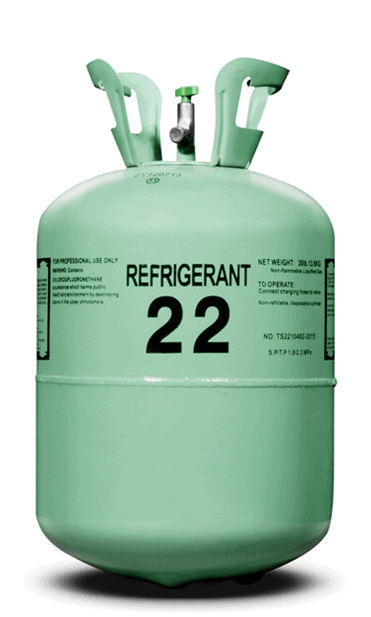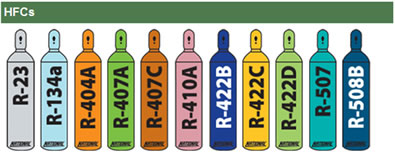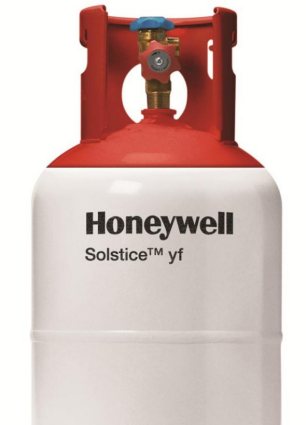What is there to watch for in 2015? What product is being phased out? What is being introduced? What new regulations are coming? I followed the industry fairly close in 2014 and have come to the following conclusions on what to look for in 2015. I am by no means the end all say all on the refrigerant market but I feel that I have a pretty good pulse on the industry.
1) R-22 Phase Out for 2015

Everybody already knows that R-22 is being phased out and that it was banned from being used in new machines in 2010. This obviously caused the price of R-22 to sky rocket up to around $300.00 a cylinder. Well in 2010 there was also the regulation that 75% of production and imports of R-22 were to be cut. Basically the market on R-22 shrunk by 3/4 in a year. Well, now in 2015 the number is 90% reduction. This sounds like quite a bit, but it’s really only another 15% reduction from 2010’s number of 75%. Even though it is only 15% the price on R-22 is still going to be climbing. I wouldn’t predict a huge increase in 2015 but keep in mind that the market did just shrink another 15%. The next big change on R-22 is in 2020 when the cut is at 99.5 percent. At that point R-22 will be similar to R-12 where it is extremely difficult to find and could cost upwards of $1,000 a cylinder.
R-22’s phase out schedule can be found by visiting the EPA’s site or by reading an excerpt below:
- January 1, 2004:
- The Montreal Protocol required the U.S. to reduce its consumption of HCFCs by 35% below the U.S. baseline cap. As of January 1, 2003, EPA banned production and import of HCFC-141b, the most ozone-destructive HCFC. This action allowed the United States to meet its obligations under the Montreal Protocol. EPA was able to issue 100% of company baseline allowances for production and import of HCFC-22 and HCFC-142b.
- January 1, 2010:
- The Montreal Protocol requires the U.S. to reduce its consumption of HCFCs by 75% below the U.S. baseline. Allowance holders may only produce or import HCFC-22 to service existing equipment. Virgin R-22 may not be used in new equipment. As a result, heating, ventilation and air-conditioning (HVAC) system manufacturers may not produce new air conditioners and heat pumps containing R-22.
- January 1, 2015:
- The Montreal Protocol requires the U.S. to reduce its consumption of HCFCs by 90% below the U.S. baseline.
- January 1, 2020:
- The Montreal Protocol requires the U.S. to reduce its consumption of HCFCs by 99.5% below the U.S. baseline. Refrigerant that has been recovered and recycled/reclaimed will be allowed beyond 2020 to service existing systems, but chemical manufacturers will no longer be able to produce R-22 to service existing air conditioners and heat pumps.
2) HFCs are Slowly Being Phased-Out

HFC refrigerants such as R-134a, R-410a, or R-404a have not been around for a long time but they are already being pushed around the world to be discontinued. The most common of the HFCs, R-134a, was already banned in the European Union in 2011. In fall of 2014 the Obama administration stated that they would be taking actions against HFC refrigerants. These actions would include a variety of voluntarily measures by companies in the United States as well as executive actions directly by Obama. I wrote an article about this in more detail about a month ago, you can find it by clicking here.
One thing to keep in mind is that the push to discontinue HFC refrigerants is not just in the United States and the EU. In 2014 the three North American countries submitted an amendment proposal to the Montreal Protocol to ban HFCs throughout the world. The Montreal Protocol is one of the biggest co-operative country agreement treaty and was originally created to combat the damaged O-Zone layer. One of the regulations in the treaty was to phase out chemicals that contained high amounts of Chlorine as it was found that Chlorine directly damaged the O-Zone layer. Countries in 2014 and 2015 are now pushing to add HFCs to this treaty even though HFCs contain little or no Chlorine. The reason for the push on HFCs boils down to their global warming potential, or GWP. Even though they don’t harm the O-Zone their global warming potential is so high that it is causing excessive amounts of green house gases and is warming the environment at an alarmingly rate.
Now it’s had to say if prices on HFCs are going to be impacted by these measures in the United States. We are still in the early stages and most steps are voluntarily. Nothing is being shoved down our throats so I do not believe the market is threatened at this time. One thing to mention is on R-134a. In 2014 there was a lawsuit filed with the International Trade Commission by Mexi-Chem, a refrigerant manufacturer. This lawsuit was against the Chinese imported 134a cylinders. It basically stated that the imported Chinese product was being brought in at an unfair price due to Chinese government subsidies. Mexi-Chem proposed adding tariffs to the imported product to make it easier for North American manufacturers to compete. The ITC ruled against Mexi-Chem in late 2014 saying that the Chinese imports were not hurting the United States industry. Well, in January of 2015 Mexi-Chem appealed the ruling and are still pushing for tariffs. So, R-134a pricing is very much up in the air for 2015.
3) The Rise of HFOs

Well, since HFCs are being phased out they obviously have to be replaced by something… and that something is HFO refrigerants. The first major HFO that is coming to prominence is the 1234YF R-134a alternative. The main bonus of HFOs is that their global warming potential is hugely lower than their HFC alternatives. For example, R134a has a GWP of 1,320. The replacement for 134a, 1234YF, has a global warming potential of 4. Obviously quite the difference here between the two of them.
HFOs for the most part haven’t had much resistance in being the new main stream refrigerant. The main argument against them is their increased flammability. Most studies have come back saying that there is not a risk using the HFOs and these studies have been completed all over the world. It is not one party doing all of these studies, various independent groups our countries have done studies and have approved it’s usage. (Including the United States Environmental Protection Agency as well as the European Union.) Daimler out of Germany has been one of the resistant voices in the switch over and had completed studies showing that the refrigerant did in fact ignite during a simulated automobile accident. Other companies have not been able to replicate these tests. Germany is still pushing against 1234YF and are more in favor of a Carbon Dioxide refrigerant alternative.
Regardless of what you or I think about HFOs they are the future and will begin showing up in various new machines. Many automobile manufacturers have begun switching production over to 1234YF and HoneyWell & DuPont have opened multiple factories dedicated to HFO production. The demand is coming, are you ready?
Conclusion
In conclusion:
- R-22 production is now even lower in 2015
- HFCs including 134a, 410a, 404a are all on the way out.
- HFOs are the future and you will begin hearing about them more and more.
As always if you are looking to purchase refrigerant please visit our bulk purchasing page.